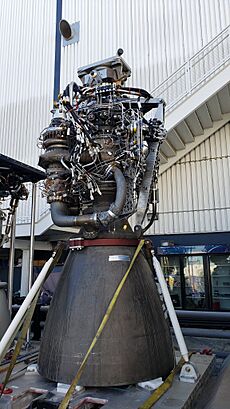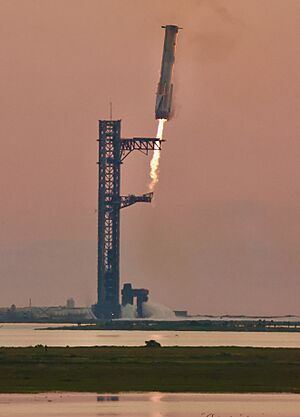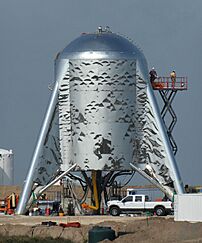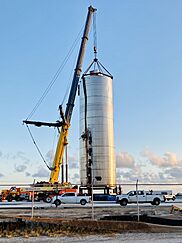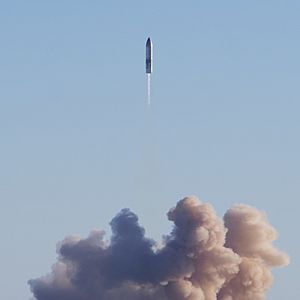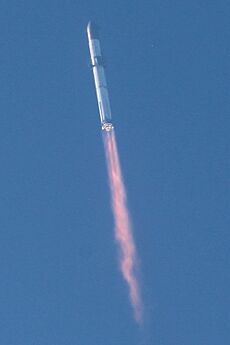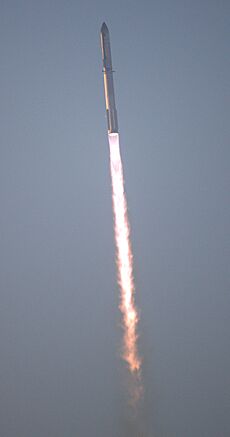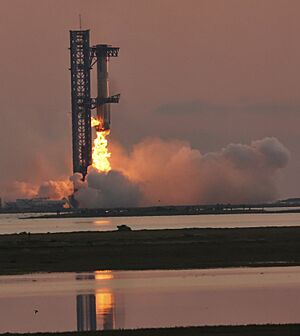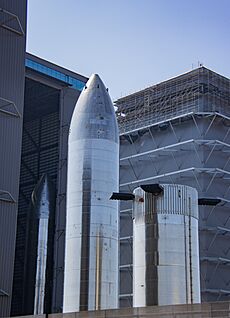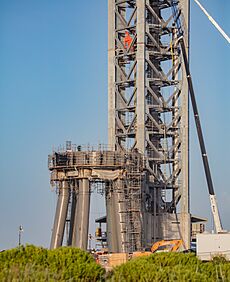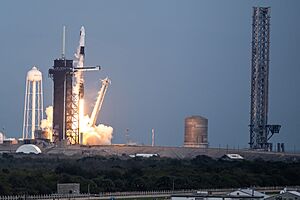SpaceX Starship facts for kids
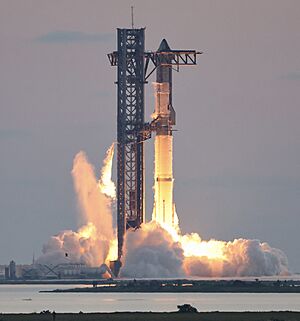
Starship ignition during launch on its fifth flight
|
|||||||||||||||||||||||||||||||||||||||||||
| Function | Super heavy-lift launch vehicle | ||||||||||||||||||||||||||||||||||||||||||
|---|---|---|---|---|---|---|---|---|---|---|---|---|---|---|---|---|---|---|---|---|---|---|---|---|---|---|---|---|---|---|---|---|---|---|---|---|---|---|---|---|---|---|---|
| Project cost | At least US$5 billion | ||||||||||||||||||||||||||||||||||||||||||
| Cost per launch | $100 million (expendable) | ||||||||||||||||||||||||||||||||||||||||||
| Size | |||||||||||||||||||||||||||||||||||||||||||
| Height |
|
||||||||||||||||||||||||||||||||||||||||||
| Diameter | 9 m (30 ft) | ||||||||||||||||||||||||||||||||||||||||||
| Mass | 5,000 t (11,000,000 lb) | ||||||||||||||||||||||||||||||||||||||||||
| Stages | 2 | ||||||||||||||||||||||||||||||||||||||||||
| Capacity | |||||||||||||||||||||||||||||||||||||||||||
| Payload to LEO |
|
||||||||||||||||||||||||||||||||||||||||||
| Associated rockets | |||||||||||||||||||||||||||||||||||||||||||
| Comparable |
|
||||||||||||||||||||||||||||||||||||||||||
| Launch history | |||||||||||||||||||||||||||||||||||||||||||
| Status | In Development | ||||||||||||||||||||||||||||||||||||||||||
| Launch sites |
|
||||||||||||||||||||||||||||||||||||||||||
| Total launches |
5
Block 1: [INVALID OR MISSING PARAMETER IN Template:SpaceX Starship Statistics]
Block 2: [INVALID OR MISSING PARAMETER IN Template:SpaceX Starship Statistics] Block 3: 0 |
||||||||||||||||||||||||||||||||||||||||||
| Successes |
3
Block 1: [INVALID OR MISSING PARAMETER IN Template:SpaceX Starship Statistics]
Block 2: [INVALID OR MISSING PARAMETER IN Template:SpaceX Starship Statistics] Block 3: 0 |
||||||||||||||||||||||||||||||||||||||||||
| Failures |
2
Block 1: [INVALID OR MISSING PARAMETER IN Template:SpaceX Starship Statistics] (FT-1, FT-2)
Block 2: [INVALID OR MISSING PARAMETER IN Template:SpaceX Starship Statistics] (FT-7, FT-8, FT-9) Block 3: 0 |
||||||||||||||||||||||||||||||||||||||||||
| First flight | April 20, 2023 | ||||||||||||||||||||||||||||||||||||||||||
| Last flight | May 27, 2025 | ||||||||||||||||||||||||||||||||||||||||||
|
|||||||||||||||||||||||||||||||||||||||||||
Starship is a giant rocket system being built by the American company SpaceX. It is made of two main parts: a powerful booster called Super Heavy and the Starship spacecraft itself. Both parts are designed to be fully reusable, meaning they can land back on Earth and be used again for future missions. This helps make space travel much cheaper.
Starship is meant to replace SpaceX's older rockets, Falcon 9 and Falcon Heavy. If it works as planned, it will be the first fully reusable rocket to reach orbit. It will also be able to carry the heaviest payloads (cargo) into space compared to any other rocket ever built. As of July 2025, Starship has launched 5 times. There have been 3 successful flights and 2 failures.
Both parts of Starship use special engines called Raptor engines. These engines burn liquid methane (like natural gas) and liquid oxygen. After launch, both the Super Heavy booster and the Starship spacecraft are designed to fly back to their launch site and land upright. Once in space, the Starship spacecraft can carry astronauts or cargo. For missions far from Earth, like to the Moon or Mars, Starship needs to be refueled in space by other Starship "tanker" spacecraft. When its mission is over, Starship returns to Earth, protected by special heat shield tiles, similar to those used on the Space Shuttle.
SpaceX hopes Starship can do many different jobs. These include launching huge satellites, parts for space stations, and large space telescopes. A special version, called the Starship Human Landing System, is being built for NASA. This version is planned to take astronauts to the Moon as part of the Artemis program, possibly starting in 2027 with Artemis III. SpaceX also dreams of using Starship to send people to Mars.
SpaceX started thinking about a super-powerful reusable rocket way back in 2005. It was first called BFR (Big Falcon Rocket). The current design and name, Starship, were introduced in 2018. SpaceX has been testing Starship by building many prototypes and doing lots of test flights. The first full Starship launch happened on April 20, 2023. It ended with the rocket exploding about four minutes after liftoff. The project has faced some delays and challenges, including four spacecraft failures in early 2025.
Contents
- What is Starship?
- Different Versions of Starship
- How Starship Launches and Lands
- Starship's Development Journey
- Cost and Funding
- What Starship Can Do
- Starship Facilities
- Other Countries and Starship
- See also
What is Starship?
When fully put together and fueled, Starship is about 121.3 m (398 ft) tall. That's taller than a 40-story building! It weighs around 5,000 t (11,000,000 lb). The rocket is designed to be fully reusable to lower the cost of sending things into space. It has two main parts: the Super Heavy booster and the Starship upper stage. Both are powered by Raptor engines.
The rocket's body is made from stainless steel. It's built by stacking and welding steel cylinders. These cylinders are about 6 ft (1.83 m) tall and 3.97 mm (0.156 in) thick. Inside the spacecraft, domes separate the tanks that hold the methane and oxygen fuel. SpaceX says that Starship, when reused, can carry 100–150 t (220,000–331,000 lb) to low Earth orbit.
The Super Heavy Booster
The Super Heavy booster is the first and largest part of the Starship system. It is 71 m (233 ft) tall and has 33 Raptor engines at its base. These engines provide the massive push needed to lift the entire Starship system off the ground. The booster's main job is to get the Starship spacecraft high enough and fast enough before separating. It then flies back to the launch site and is caught by the launch tower's arms, ready to be used again.
The Starship Spacecraft
The Starship spacecraft is the second part of the system. It sits on top of the Super Heavy booster. This part is designed to go into space, carry people or cargo, and even travel to the Moon or Mars. It has six Raptor engines: three for use in Earth's atmosphere and three special ones for the vacuum of space. The Starship spacecraft also has four flaps that help it steer and control its descent when returning to Earth.
Raptor Engines
Raptor engines are the powerful engines that make Starship fly. SpaceX developed them specifically for Starship and Super Heavy. They burn liquid oxygen and methane fuel in a very efficient way. Methane is used instead of other fuels like kerosene because it performs better and keeps the engine cleaner. Methane can also be made on Mars from carbon dioxide and water, which is important for future missions there. These engines are built to be reused many times without needing much repair.
A Raptor 2 engine can produce a huge amount of power, about 2.3 MN (520,000 lbf) of thrust. The engines are mostly made of aluminum, copper, and steel. Some parts are even made using 3D printing. The Raptor engines can also tilt, which helps steer the rocket during flight. SpaceX hopes to make these engines very cheaply once they are mass-produced.
Different Versions of Starship
| Block | 1 | 2 | 3 | 4 |
|---|---|---|---|---|
| Payload to orbit (t) | N/A | 100+ | 200+ | 300+ |
| Booster prop load (t) | 3,300 | 3,650 | 3,650 | |
| Ship prop load (t) | 1,200 | 1,500 | 1,550 | 2300 |
| Booster liftoff thrust (tf) | 7,500 | 8,240 | 10,000 | |
| Ship initial thrust (tf) | 1,250 | 1,600 | 2,700 | |
| Ship SL engines | 3 | 3 | ||
| Ship VAC engines | 3 | 6 | ||
| Booster height (m) | 71 | 72.3 | 81 | |
| Ship height (m) | 50.3 | 52.1 | 61 | |
| Total height (m) | 121.3 | 123.3 | 124.4 | 142 |
SpaceX has been improving Starship over time, creating different "Blocks" or versions. In April 2024, Elon Musk announced two new versions: Block 2 and Block 3.
Block 1 Starship
Block 1 Starship vehicles were used for the first six test flights. These versions are now retired.
Block 2 Starship
Block 2 vehicles started being used for both the booster and spacecraft from flight test 7 in early 2025. The Block 2 spacecraft is taller and has thinner flaps. It can also hold more fuel. These vehicles use improved Raptor 3 engines. Block 2 Starship is planned to carry at least 100 tons of payload into orbit when reused.
Block 3 Starship
The final design for Block 3 is still being worked on. This version is expected to be even taller, around 150 m (490 ft). It might have more engines: nine on the Starship spacecraft and up to 35 on the Super Heavy booster. Block 3 is planned to carry at least 200 tons into orbit when reused.
How Starship Launches and Lands
First, the Starship spacecraft is attached to the Super Heavy booster at the launch site. Then, they are filled with fuel. All 33 engines of Super Heavy ignite, and the rocket lifts off.
About 2.5 minutes after launch, at an altitude of about 64 km (40 mi), the Starship spacecraft separates from the booster. This happens while Starship's own engines are already firing, a technique called "hot-staging." The Super Heavy booster then turns around and fires some of its engines to slow down. It guides itself back to the launch site using special "grid fins" for steering. About six minutes after launch, the booster fires its engines again to slow down for landing. It is then caught by giant robotic arms on the launch tower. This "catch" was successfully done for the first time on October 13, 2024, with Booster 12.
Meanwhile, the Starship spacecraft continues flying into space, using its six Raptor engines to reach orbital speed. Once in orbit, it can be refueled by other Starship tankers. For missions to the Moon, NASA estimated that about 16 refueling launches might be needed. To land on planets without an atmosphere, like the Moon, Starship fires its engines to slow down. For planets with an atmosphere, like Earth or Mars, Starship uses a heat shield to slow down by rubbing against the air. It then performs a "belly-flop" maneuver, falling through the atmosphere on its side, using its four flaps to control its fall. Just before landing, it flips upright and fires its engines to land softly.
If Starship lands on a pad, a special lift moves it to a transport vehicle. If it lands on a floating platform in the ocean, it's brought to a port by a barge. The recovered Starship can then be prepared for its next launch or taken to a SpaceX facility for maintenance.
Starship's Development Journey
Early Ideas (2012–2019)

SpaceX CEO Elon Musk first talked about a huge rocket in 2005. In 2012, he publicly announced plans for a rocket even bigger than SpaceX's Falcon 9. It was first called the Mars Colonial Transporter, meant to take people to Mars. In 2016, it became the Interplanetary Transport System, planned to travel even further. By 2017, it was renamed the BFR.
In December 2018, SpaceX decided to build the rocket out of stainless steel instead of carbon fiber. This was because steel is cheaper, easier to work with, and stronger in very cold temperatures and high heat. In 2019, the whole rocket system was named Starship. The booster became Super Heavy, and the upper stage was also called Starship. SpaceX also announced that Starship would use reusable heat shield tiles, like those on the Space Shuttle.
Low-Altitude Test Flights (2019–2021)
Starhopper and Early Prototypes
Testing began in 2018 with a prototype called Starhopper. It performed several engine tests and two successful short flights in 2019. SpaceX then started building full-size Starship prototypes, like MK1 and MK2. These early prototypes did not fly. MK1 was destroyed during a pressure test.
SpaceX then started naming its new Starship prototypes with "SN" (serial number). Some early SN prototypes also failed during tests. The first flight-capable prototype, SN5, was a simple cylinder without flaps or a nose cone. On August 5, 2020, SN5 flew 150 m (500 ft) high and landed successfully. A similar prototype, Starship SN6, repeated this hop in September 2020.
High-Altitude Test Flights (SN8 to SN15)
Starship SN8 was the first full-sized prototype to fly high, reaching 12.5 km (7.8 mi) on December 9, 2020. It performed a controlled descent but crashed during landing due to low fuel pressure. The Federal Aviation Administration (FAA) investigated this incident because SpaceX had not followed all safety rules.
Later prototypes, Starship SN9 and Starship SN10, also flew to high altitudes but crashed during landing. Starship SN11 exploded during its descent. These tests helped SpaceX learn a lot about how to improve the design.
In March 2021, SpaceX announced plans to build more launch pads and test sites. They also proposed turning the nearby village into a company town called Starbase.
Finally, on May 5, 2021, SN15 successfully launched, performed its maneuvers, and landed safely. This was a big step forward for the program.
Integrated Flight Tests (2023–)
Before full-scale flight tests could begin, the FAA required SpaceX to fix many issues found in their environmental review.
First Flight Test
In July 2022, a test of the Booster 7 engines caused an explosion at its base. After more tests, Booster 7 and Ship 24 launched on April 20, 2023. Several engines failed during the launch, and the rocket lost control. It reached a height of 39 km (24 mi) before its flight termination system activated, causing it to break apart. The launch also kicked up a lot of sand and caused a small brushfire nearby.
Second Flight Test
After the first flight, SpaceX repaired the launch pad and added a water-powered flame deflector. On November 18, 2023, Booster 9 and Ship 25 launched. All 33 engines worked until separation. The Super Heavy booster exploded during its return attempt due to engine failures. The Starship spacecraft continued to about 149 kilometres (93 mi) altitude before its flight termination system activated, destroying it.
Third Flight Test
After the second flight, Starship's control system was improved. Flight 3 launched on March 14, 2024. The booster successfully separated but exploded just before landing in the Gulf of Mexico. The Starship spacecraft reached space and performed tests, including a fuel transfer demo. It then tried to re-enter the atmosphere but contact was lost at about 65 km (40 mi) altitude. The fuel transfer test was important for future Moon missions.
Fourth Flight Test
The fourth flight test launched on June 6, 2024. The main goals were for the Super Heavy booster to land softly in the ocean (a "virtual tower" landing) and for the Starship spacecraft to survive the intense heat of re-entering Earth's atmosphere. Both goals were achieved, marking a big success for the program.
Fifth Flight Test
SpaceX aimed to catch the booster with the launch tower arms during this flight. On October 13, 2024, SpaceX launched S30 and B12. Booster 12 successfully returned to the launch site and was caught by the tower arms for the first time! Ship 30 also landed successfully in the Indian Ocean.
Sixth Flight Test
Flight 6 launched on November 19, 2024. The booster landed in the water instead of being caught. This flight was the first to successfully restart a Raptor engine in the vacuum of space. This is a key step for future missions that need to deploy satellites. A stuffed toy banana was the first "payload" on Starship, staying inside the vehicle during the flight.
Seventh Flight Test
Flight 7 launched on January 16, 2025. The mission aimed for a splashdown in the Indian Ocean and to deploy ten Starlink "simulators." Contact with Ship 33 was lost shortly before its engines were supposed to shut down. The spacecraft was seen exploding over the Turks and Caicos Islands. However, the booster successfully returned to the launch site and was caught by the tower.
Eighth Flight Test
The eighth flight test launched on March 6, 2025. The Super Heavy booster was successfully caught by the launch tower again. However, during Ship 34's flight, four of its six engines shut down too early. This caused the spacecraft to lose control and break apart. Communications with the spacecraft ended about 9.5 minutes after liftoff.
Ninth Flight Test
Starship's ninth flight test launched on May 27, 2025. This was the first time a Super Heavy booster was reused. The booster completed its flight but was lost before its planned splashdown. Ship 35 reached engine cutoff, but a fuel leak caused it to lose control, and it broke up during re-entry. It also failed to deploy its dummy satellites.
Ship 36 Explosion
On June 18, 2025, Ship 36, a Block 2 spacecraft planned for the tenth flight test, exploded during an engine test. This happened because a pressure tank in the nose section broke, igniting the fuel. No one was hurt, but SpaceX paused testing to check other Block 2 parts and repair the test stand.
Cost and Funding
SpaceX mostly uses its own money to develop Starship. The company has spent over $3 billion on the Starbase facility and Starship systems between 2014 and 2023. In 2023, Elon Musk said SpaceX expected to spend about $2 billion on Starship development that year alone.
Musk has suggested that a Starship launch might eventually cost SpaceX only $1 million. However, experts believe the price for customers will likely be higher due to the huge development costs.
NASA has also given SpaceX contracts to develop the Starship lunar lander for the Artemis program. In April 2021, SpaceX received a $2.89 billion contract for the lunar lander for Artemis III. In 2022, NASA gave SpaceX another $1.15 billion contract for a second lunar lander for Artemis IV.
What Starship Can Do
Starlink Satellites
SpaceX plans to use Starship to launch the next generation of its Starlink satellites. Starlink provides high-speed internet to many countries. Starship's large capacity will make launching these satellites cheaper.
Artemis Program (Moon Missions)
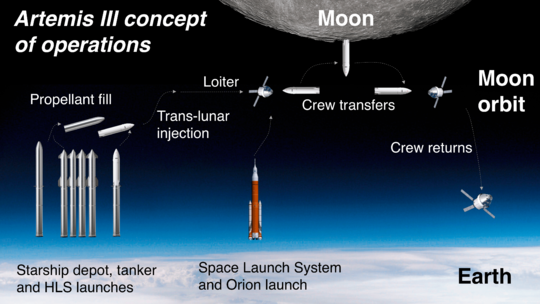
The Starship HLS is NASA's chosen lunar lander for the Artemis III and Artemis IV missions. Starship HLS will launch into Earth orbit and be refueled by other Starship tanker spacecraft. Once fueled, it will travel to the Moon. The Orion spacecraft will dock with Starship HLS, and two astronauts will transfer to the lander. Starship HLS will then land near the Moon's south pole. After exploring, the crew will return to Orion and head back to Earth.
Space Telescopes
Astronomers are excited about Starship's ability to carry very large space telescopes. Starship's wide cargo bay could fit an 8 m (26 ft) wide telescope mirror in one piece. This would avoid the need for complex folding, which added cost and delays to telescopes like the JWST. Starship's lower launch cost could also allow telescopes to use heavier, cheaper materials.
The Habitable Worlds Observatory (HWO), a future space observatory, needs a super heavy-lift rocket like Starship. The HWO will search for signs of life on planets outside our solar system.
Rocket Cargo
In January 2022, SpaceX received a $102 million contract from the United States Space Force for the Rocket Cargo program. This program will explore using Starship to quickly transport up to 100 tons of cargo and supplies anywhere on Earth. A test flight for this "point-to-point delivery" is planned for 2025 or 2026.
Mars Sample Return
The NASA-ESA Mars Sample Return project aims to bring samples from Mars back to Earth. In 2024, the original plan for this project faced problems. NASA is now looking for new ideas from companies like SpaceX. Starship is a strong candidate to help with this important mission.
Earth to Earth Travel
SpaceX has suggested using Starship for "Earth to Earth" flights. This means traveling anywhere on Earth in less than an hour. Elon Musk said that hundreds of cargo flights would happen before human passengers are carried this way.
Space Colonization
SpaceX says Starship's design is driven by the goal of landing crews on Mars. After landing on Mars, Starship could make its own fuel using Martian water and Martian carbon dioxide. This would allow Starship to return to Earth.
SpaceX and Elon Musk want to colonize Mars to help humanity survive long-term. Musk hopes to send one million people to Mars by 2050. However, some experts say this timeline is very ambitious because we still need to develop many technologies for living on Mars.
Other Missions
Starship is also planned to launch other payloads. These include the Superbird-9 communication satellite and the Starlab space station, which Starship will launch in one piece.
In the future, the crewed version of Starship could be used for space tourism. For example, it could be used for the third flight of the Polaris program.
Starship Facilities
Testing and Manufacturing
Starbase in Boca Chica, Texas, is where Starship is built and launched. Both the manufacturing and launch sites operate 24 hours a day. The site includes two launch sites, a facility for preparing payloads, a large solar farm, and other buildings.
Raptor engines are tested at the Rocket Development facility in McGregor, Texas. This facility has different test stands for the engines.
In Florida, a facility in Cocoa purifies material for Starship's heat shield tiles. The Kennedy Space Center in Florida is also planned to have Starship facilities, including a launch site at Launch Complex 39A and a production facility. Another launch site is proposed at Cape Canaveral Space Launch Complex 37 (SLC-37).
Launch Sites
Starbase Launch Site
Starbase is planned to have two launch sites, Pad A and Pad B. Each site has large facilities like a tank farm for fuel, an orbital launch mount, and a tall integration tower. The current launch mount on Pad A has a water-powered flame diverter and clamps to hold the booster.
The integration tower, or launch tower, is made of steel sections. It has a lightning rod on top and two robotic arms. These arms can lift the booster, and also catch and recover it after landing. Catching the booster with arms helps make the rocket lighter and allows for faster reuse. The arms move up and down using a pulley system and can also move horizontally.
Florida Launch Sites
SpaceX has been building a Starship launch pad at Kennedy Space Center Launch Complex 39A (LC-39A) since 2021. This site is also used to launch Falcon 9 rockets. The FAA is currently studying the environmental effects of building new facilities and launching more rockets from LC-39A.
Other rocket companies, like Blue Origin and United Launch Alliance (ULA), have raised concerns about how Starship launches might affect their operations in Florida. They worry about the large safety zones needed for Starship launches. Elon Musk has suggested that these concerns are meant to slow down SpaceX's progress.
SpaceX has also proposed building another Starship launch pad at the nearby Cape Canaveral Space Launch Complex 37 (SLC-37). Both environmental reviews for the Florida sites must be finished before Starship can launch from there, likely not until late 2025.
Other Countries and Starship
Other countries are also working on rockets similar to Starship. For example, the China Aerospace Science and Tech Corp is reportedly developing its own reusable super-heavy lift rocket, the Long March 9, which looks similar to Starship. Chinese companies are also developing smaller Starship-like rockets.
In 2021, members of the U.S. Congress expressed concerns about the FAA's response to SpaceX's safety violations during early Starship tests. In 2023, SpaceX's vice president, Bill Gerstenmaier, spoke to the U.S. Senate. He emphasized the importance of innovation for space travel, especially with competition from countries like China. He said that Starship's test flights were being slowed down by "unnecessary bureaucracy."
After Starship's second flight test, the Government Accountability Office (GAO) suggested that the FAA improve how it investigates rocket accidents. Some environmental groups have also sued the FAA and SpaceX, claiming that environmental reviews were not done properly.
See also
 In Spanish: Starship (SpaceX) para niños
In Spanish: Starship (SpaceX) para niños
- Comparison of orbital launch systems
- Comparison of orbital launcher families
- SpaceX reusable launch system development program


